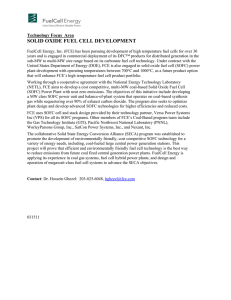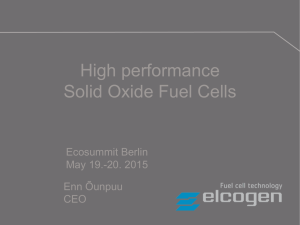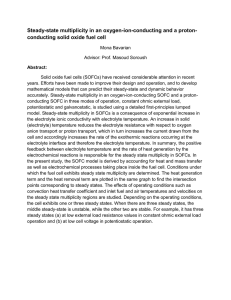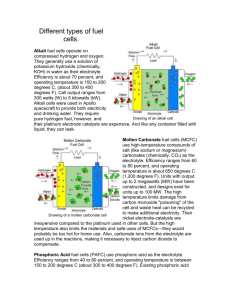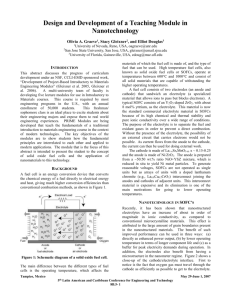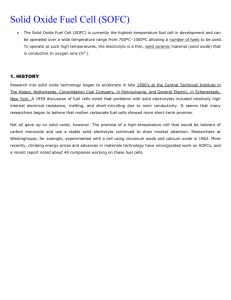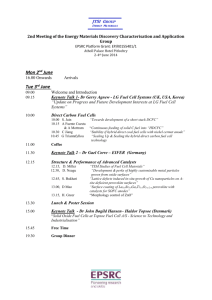Solid Oxide Fuel Cell (SOFC)
advertisement
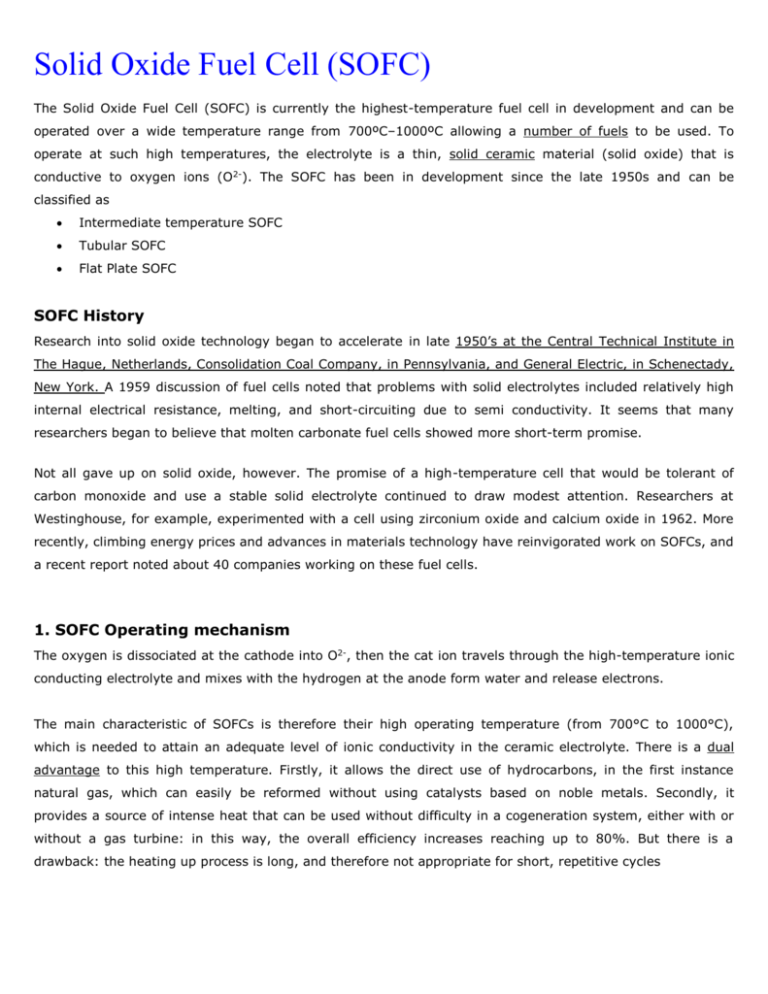
Solid Oxide Fuel Cell (SOFC) The Solid Oxide Fuel Cell (SOFC) is currently the highest-temperature fuel cell in development and can be operated over a wide temperature range from 700ºC–1000ºC allowing a number of fuels to be used. To operate at such high temperatures, the electrolyte is a thin, solid ceramic material (solid oxide) that is conductive to oxygen ions (O2-). The SOFC has been in development since the late 1950s and can be classified as Intermediate temperature SOFC Tubular SOFC Flat Plate SOFC SOFC History Research into solid oxide technology began to accelerate in late 1950’s at the Central Technical Institute in The Hague, Netherlands, Consolidation Coal Company, in Pennsylvania, and General Electric, in Schenectady, New York. A 1959 discussion of fuel cells noted that problems with solid electrolytes included relatively high internal electrical resistance, melting, and short-circuiting due to semi conductivity. It seems that many researchers began to believe that molten carbonate fuel cells showed more short-term promise. Not all gave up on solid oxide, however. The promise of a high-temperature cell that would be tolerant of carbon monoxide and use a stable solid electrolyte continued to draw modest attention. Researchers at Westinghouse, for example, experimented with a cell using zirconium oxide and calcium oxide in 1962. More recently, climbing energy prices and advances in materials technology have reinvigorated work on SOFCs, and a recent report noted about 40 companies working on these fuel cells. 1. SOFC Operating mechanism The oxygen is dissociated at the cathode into O2-, then the cat ion travels through the high-temperature ionic conducting electrolyte and mixes with the hydrogen at the anode form water and release electrons. The main characteristic of SOFCs is therefore their high operating temperature (from 700°C to 1000°C), which is needed to attain an adequate level of ionic conductivity in the ceramic electrolyte. There is a dual advantage to this high temperature. Firstly, it allows the direct use of hydrocarbons, in the first instance natural gas, which can easily be reformed without using catalysts based on noble metals. Secondly, it provides a source of intense heat that can be used without difficulty in a cogeneration system, either with or without a gas turbine: in this way, the overall efficiency increases reaching up to 80%. But there is a drawback: the heating up process is long, and therefore not appropriate for short, repetitive cycles 2. SOFC Features SOFCs are fuel cells that operate at high temperatures between 700 and 1000°C, and have the following advantages over proton exchange membrane fuel cells that have been developed for fuel cell automobiles and households. 1) Higher power generation efficiency. 2) Higher exhaust gas temperature, with a potential of the value added utilization of exhaust heat in the form of steam generation or others. 3) Capable of generating power with fuel in a broad range covering not only hydrogen but carbon monoxide as well. 4) Permits simplification of fuel modification system components, because of its internal fuel property modification capability. 5) Expectable higher durability, because the electrolyte is solid consisting mainly of ceramics. 6) No noble metal used in the electrodes. 7) High temperature operation removes the need for precious-metal catalyst, thereby reducing cost. 3. Block Diagrams (Various Fuel cells) 4. Future Scope (SOFC) Scientists are currently exploring the potential for developing lower-temperature SOFCs operating at or below 800°C that have fewer durability problems and cost less. Lower-temperature SOFCs produce less electrical power, however, and stack materials that will function in this lower temperature range have not been identified. 5. Some useful links http://www.eere.energy.gov/hydrogenandfuelcells/fuelcells/fc_types.html http://www.personal.psu.edu/users/a/b/abs193/activities/cause_2003/renewable_energy_presentation.pdf http://www.benwiens.com/energy4.html http://www.fctec.com/fctec_types_sofc.asp http://www.cea.fr/gb/publications/Clefs44/an-clefs44/clefs4453a.html http://www0.nsc.co.jp/shinnihon_english/kenkyusho/contenthtml/n92/n9216.pdf http://www.iit.edu/~smart/garrear/fuelcells.htm

